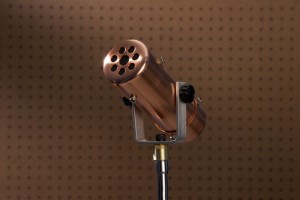 Whether an artist or producer is looking for something unique to use as an effects microphone to accentuate certain lyrics, give a song a certain feel, or perhaps add to an arsenal that strives for a nostalgic sound, the Copperphone can fit the bill. It is a dynamic, cardioid mic, which according to the Placid Audio website, “operates within a limited bandwidth of frequencies which lends a nostalgic quality to the signal.” It’s a bit of a monster, with a frequency response of 200 Hz-3kHz, an impedance of 150 ohms, an output of 115 +/- 2dB SPL @ 1 kHz, and dimensions of 2.5 x 6” with a weight of 1.75 lbs. Versatility relies on the user’s goals. Some use it for vocals, separately or in combination with other mics, while others use it for instrument or audio effects, either live or in-studio.
Whether an artist or producer is looking for something unique to use as an effects microphone to accentuate certain lyrics, give a song a certain feel, or perhaps add to an arsenal that strives for a nostalgic sound, the Copperphone can fit the bill. It is a dynamic, cardioid mic, which according to the Placid Audio website, “operates within a limited bandwidth of frequencies which lends a nostalgic quality to the signal.” It’s a bit of a monster, with a frequency response of 200 Hz-3kHz, an impedance of 150 ohms, an output of 115 +/- 2dB SPL @ 1 kHz, and dimensions of 2.5 x 6” with a weight of 1.75 lbs. Versatility relies on the user’s goals. Some use it for vocals, separately or in combination with other mics, while others use it for instrument or audio effects, either live or in-studio.
WATCH: Lou Barlow using the Copperphone live!
Notably, the Copperphone was used by scoring mixer Dan Wallin to make the intro for the movie Up feel like an old-time recording. It’s also been used in-studio by Jack White’s side projects The Raconteurs and Dead Weather, as well as Norah Jones on her album The Fall. It’s been used live onstage by Queens of The Stone Age, Lou Barlow, Green Day, and for live recordings by Rush. Even contemporary pop singers like Lady Gaga have shown interest in the Copperphone.
The Copperphone came from an idea by Mark Pirro when he was a member of the band Tripping Daisy. The band’s singer, Tim DeLaughter, had found a sound effect used in-studio that was difficult to produce live. Pirro decided a separate effects mic would be the answer, so he began to study mics online.
“I studied concepts on microphone design. Basically a microphone is a speaker wired in reverse. So I started with that: using old speakers as microphones. Then I started studying the concept of mechanical filtering. Ever take a paper towel tube and put it up to your mouth and talk into it? It radically changes the sound. That’s because the tube will accentuate certain frequencies and reject other frequencies. That is part of the design of the Copperphone. It uses a chamber inside the copper tube to act as a mechanical filter. Also, part of the sound is achieved through the components [including a passive magnetic moving coil transducer], which impart their own frequency bias on the signal,” describes Pirro.
“I had to come up with a [tube] length that would have an effect, but be practical too,” he continues. “The original Copperphone was made with PVC pipe and some duct tape. When I finally had the sound I wanted, I needed to look for a housing design that was a bit more durable and attractive. At that time, in 2002, copper was pretty cheap.” To make things easy, Pirro creates the Copperphone in a small batch production line, doing everything except machining the copper, which he used to do by hand on a drill press. “The ends are held on with stainless steel hardware,” he explains, adding that this feature allows for a fix if needed, making it easy for Placid Audio to uphold their lifetime operational warranty.
Approximately 1,000 Copperphones have been sold since the first one was created almost ten years ago. Nearly 100 studios and 125 artists have used either the Copperphone or the Harmonica Mini, a smaller version of the Copperphone which has a ring mount, but is able to be dismounted to become a hand-held bullet mic. Pirro has ambitions of having a Copperphone in every studio. With its pedigree applications thus far, that may happen.
Currently, the Copperphone can also be seen in use by Pirro’s bands The Polyphonic Spree and Menkena.
